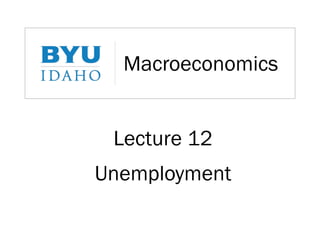
Lecture 12 unemployment
- 2. Questions
- 5. Unemployment The Monetary System Money Growth and Inflation
- 6. Unemployment
- 7. Intellectual Financial Physical Human Culture Entrepreneur trust knowledge skills personality health relationships natural resources time buildings equipment things than make things money and risk savers and borrowers time is money (1+r)n insurance limited liability corporations ideas technology methods
- 9. Key Terms labor force unemployment rate labor-force participation rate natural rate of unemployment cyclical unemployment discouraged workers frictional unemployment structural unemployment job search unemployment insurance union collective bargaining strike efficiency wages
- 10. Unemployment How is it measured? Who measures it?
- 11. Adult Population Population age 16 and older
- 12. Labor Force the total number of workers, including employed and unemployed
- 13. Labor Force Participation Rate the percent of the adult population that is in the labor force
- 14. Unemployment Rate the number of the labor force that is employed
- 15. Employed paid employees work in own business unpaid workers in family business full-time and part-time jobs but temporary absence
- 16. Unemployed not employed available tried to find a job in the last four weeks waiting to be recalled from layoff
- 17. Discouraged Workers People who would like to work but have given up looking for a job
- 18. Not in Labor Force not employed or unemployed discouraged workers full-time student homemaker retiree
- 19. Unemployment Rate The percentage of the labor force that is unemployed
- 20. 16+ 79% Under 16 21% U.S Population millions % Under 16 66 21% 16+ 254 79% Total 320 100%
- 21. Unemployed 7.7 million 3% Employed 152.3 million 60% Not in Labor Force 94 million 37% Adult Population
- 22. Unemployed 7.7 million 5% Employed 152.3 million 95% Labor Force
- 23. millions % Population % Adults % Labor Force Population 320 100% Age under 16 66 20% Age 16+ 254 80% 100% Not in Labor Force 94 30% 37% In Labor Force 160 50% 63% 100% Employed 152.3 47.6% 60% 95.2% Unemployed 7.7 2.4% 3% 4.8%
- 24. Bureau of Labor Statistics - Two Surveys The Current Population Survey (CPS) "household survey" Sample of 60,000 households. The Current Employment Statistics Survey (CES): "payroll survey" sample of 160,000 businesses and government agencies that represent 400,000 individual employees. Who Measures Unemployment?
- 25. U1: the percentage of labor force unemployed for 15 weeks or longer. U2: the percentage of labor force who lost jobs or completed temporary work. U3: the official unemployment rate that occurs when people are without jobs and they have actively looked for work within the past four weeks. U4: the individuals described in U3 plus "discouraged workers," those who have stopped looking for work because current economic conditions make them think that no work is available for them. U5: the individuals described in U4 plus other "marginally attached workers," "loosely attached workers," or those who "would like" and are able to work, but have not looked for work recently. U6: the individuals described in U5 plus part-time workers who want to work full-time, but cannot due to economic reasons, primarily underemployment. Six Measures of Unemployment
- 26. Labor-Force Participation Rate The percentage of the adult population (15+) that is in the labor force
- 27. Problems Overstate - Above actual Cash workers Understate - Below actual Discouraged workers
- 28. 1945 1950 1955 1960 1965 1970 1975 1980 1985 1990 1995 2000 2005 2010 2015 Year 0 Numb 1945 1950 1955 1960 1965 1970 1975 1980 1985 1990 1995 2000 2005 2010 2015 Year 0 20 40 60 Shareofthecivilianlaborforce(%) Hover ov Adjust ye data disp Notes: Inc civilian no that are e looking fo persons 1 The comp data has b times by m changes in Survey. Source: 1 averages, Survey, U Statistics Graph by Men Women
- 29. Natural Rate of Unemployment The normal rate of unemployment around which the unemployment rate fluctuates
- 30. Cyclical Unemployment The deviation of unemployment from its natural rate
